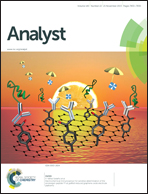Fenton reaction-mediated fluorescence quenching of N-acetyl-l-cysteine-protected gold nanoclusters: analytical applications of hydrogen peroxide, glucose, and catalase detection†
Abstract
Given the importance of hydrogen peroxide (H2O2) in many biological processes and its wide application in various industries, the demand for sensitive, accurate, and economical H2O2 sensors is high. In this study, we used Fenton reaction-stimulated fluorescence quenching of N-acetyl-L-cysteine-protected gold nanoclusters (NAC-AuNCs) as a reporter system for the determination of H2O2. After the experimental conditions were optimized, the sensing platform enabled the analysis of H2O2 with a limit of detection (LOD) as low as 0.027 μM. As the glucose oxidase cascade leads to the generation of H2O2 and catalase catalyzes the decomposition of H2O2, these two biocatalytic procedures can be probed by the Fenton reaction-mediated quenching of NAC-AuNCs. The LOD for glucose was found to be 0.18 μM, and the linear range was 0.39–27.22 μM. The LOD for catalase was 0.002 U mL−1, and the linear range was 0.01–0.3 U mL−1. Moreover, the proposed sensing methods were successfully applied for human serum glucose detection and the non-invasive determination of catalase activity in human saliva, demonstrating their great potential for practical applications.


 Please wait while we load your content...
Please wait while we load your content...